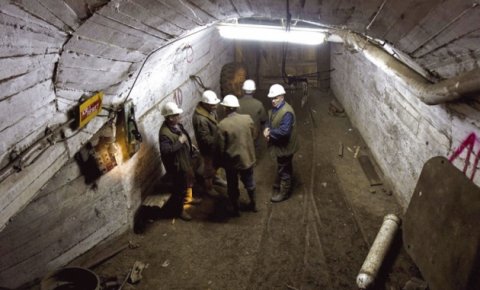Mineral wealth and jobs

South Africa’s total reserves remain some of the world’s most valuable, with an estimated worth of R20.3-trillion ($2.5-trillion). Overall, the country is estimated to have the world’s fifth-largest mining sector in terms of GDP value.
It has the world’s largest reserves of manganese and platinum group metals (PGMs), according to the US Geological Survey, and among the largest reserves of gold, diamonds, chromite ore and vanadium.
With South Africa’s economy built on gold and diamond mining, the sector is an important foreign exchange earner, with gold accounting for more than one-third of exports. In 2009, the country’s diamond industry was the fourth largest in the world. South Africa is also a major producer of coal, manganese and chrome.
There is considerable potential for the discovery of other world-class deposits in areas yet to be exhaustively explored. South Africa’s prolific mineral reserves include precious metals and minerals, energy minerals, non-ferrous metals and minerals, ferrous minerals, and industrial minerals.
Given its history and mineral wealth, it is no surprise that the country’s mining companies are key players in the global industry. Its strengths include a high level of technical and production expertise, and comprehensive research and development activities.
World-class primary processing facilities work with carbon steel, stainless steel, aluminium, gold and platinum. South Africa is also a world leader of new technologies, such as a ground-breaking process that converts low-grade superfine iron ore into high- quality iron units.
Contribution to the economy
With the growth of South Africa’s secondary and tertiary industries, the relative contribution of mining to South Africa’s gross domestic product (GDP) has declined over the past 10 to 20 years.
Nonetheless, the industry is continually adapting to changing local and international world conditions, and remains a cornerstone of the economy, making a significant contribution to economic activity, job creation and foreign exchange earnings. Mining and its related industries are critical to South Africa’s socio-economic development.
The sector accounts for roughly one-third of the market capitalisation of the JSE, and continues to act as a magnet for foreign investment in the country.
Mining, according to the Chamber of Mines:
Creates one million jobs (500 000 direct and 500 000 indirect).
Accounts for about 18% of GDP (8.6% direct, 10% indirect and induced).
Is a critical earner of foreign exchange at more than 50%.
Accounts for 20% of investment (12% direct).
Attracts significant foreign savings (R1.9-trillion or 43% of value of JSE).
Accounts for 13.2% of corporate tax receipts (R17-billion in 2010) and R6-billion in royalties.
Accounts for R441-billion in expenditures, R407-billion spent locally.
Accounts for R78-billion spent in wages and salaries.
Accounts for 50% of volume of Transnet’s rail and ports.
Accounts for 94% of electricity generation via coal power plants.
Takes 15% of electricity demand.
About 37% of the country’s liquid fuels via coal.
The chamber says total mining expenditure in 2010 was R441-billion, of which:
R228.4-billion was spent on purchases and operating costs (timber, steel, explosives, electricity, transport, uniforms, etc.
R78.4-billion went on salaries and wages for mine employees.
R49-billion on Capex (the lifeblood of mining).
R17.1-billion in tax.
R16.2-billion in dividends (only 3.7% of total).
R38-billion on depreciation and impairments.
R13-billion on interest to the banks.
Of this, R409-billion (92%) was spent locally, and the spending multipliers created as much economic value and jobs as the direct mining sector contributed. In addition, the listed mining companies represent more than 30% of the market capitalisation of the Johannesburg Stock Exchange.
There are other contributions to the economy: extraction-related industries are a key driver of the Johannesburg Stock Exchange, representing 42%, or R1.9-trillion, of its value. Mining also provides the feedstock for about 94% of the country’s electricity generating capacity.
The value of total sales increased by 24.8% to R302.2-billion ($37-billion) in 2010, and the three top-selling minerals – PGMs, coal and gold – accounted for 66.3% of total mineral sales.
South Africa’s mineral reserves are well-mapped, but despite having the world’s largest in situ value of mineral resources, the country only accounts for 3% of total greenfield mining projects planned for the next decade.
Beneficiation and other policies
In the 2011/12 Fraser Institute Survey, South Africa was ranked 54th out of 93 countries and provinces (from 67th out of 79 the year before). The Fraser Institute, a leading Canadian think tank, measures the policy attractiveness of mining destinations by polling mining company executives.
Lucrative opportunities exist for downstream processing and adding value locally to iron, carbon steel, stainless steel, aluminium, PGMs and gold. A wide range of materials is available for jewellery, other than gold, platinum and diamonds; there is also tiger’s eye, and many other semiprecious stones.
For this purpose, the government has developed a minerals beneficiation strategy as a key area for potential growth. It is planned to transform the industry from being largely resource-based to knowledge-based. Downstream activities are already well-developed, and downstream products from the industry used locally include cement, steel, liquid fuels, electricity, polymers and plastics, with an estimated total sales value of R200- billion ($24.6-billion).
South Africa’s beneficiation strategy compliments other government programmes, and the mining industry value chain has been prioritised as an economic growth node in the New Growth Path, which highlights a path for the industry out of its depression until 2020.






